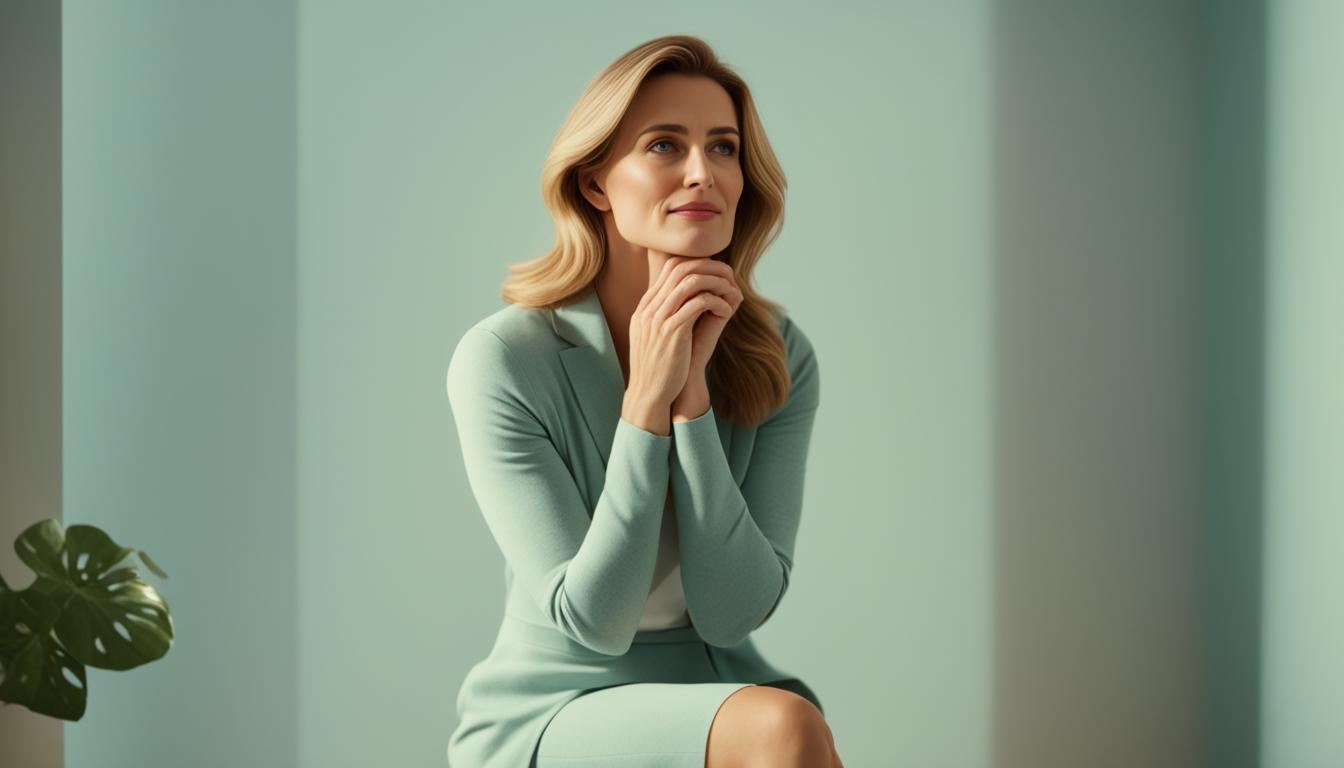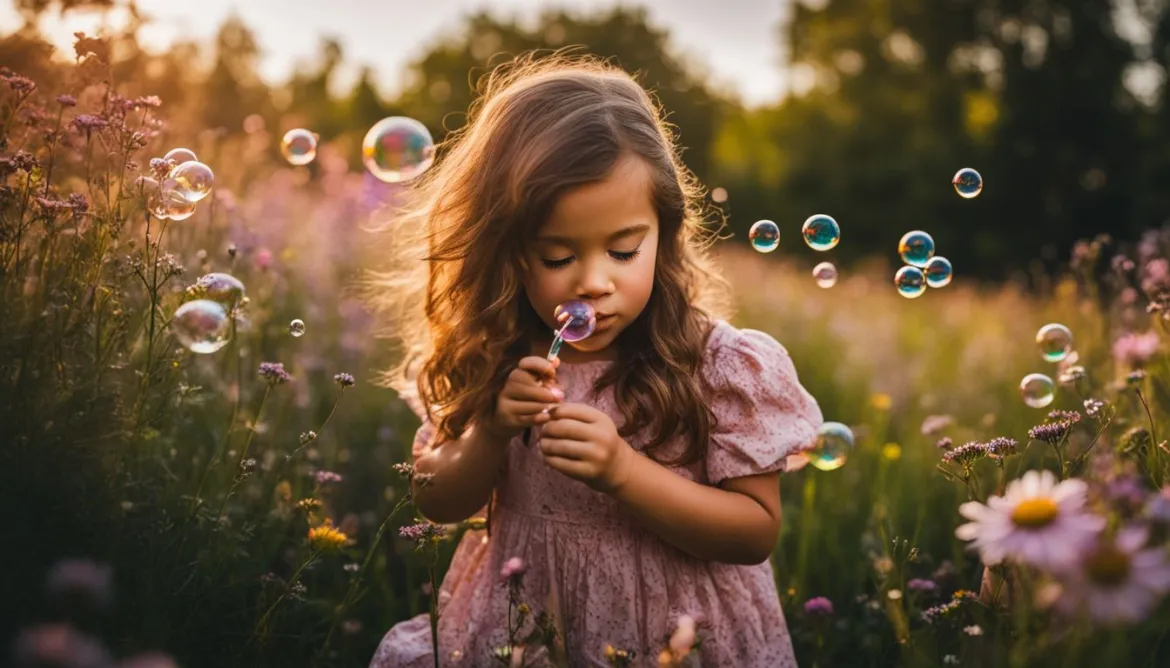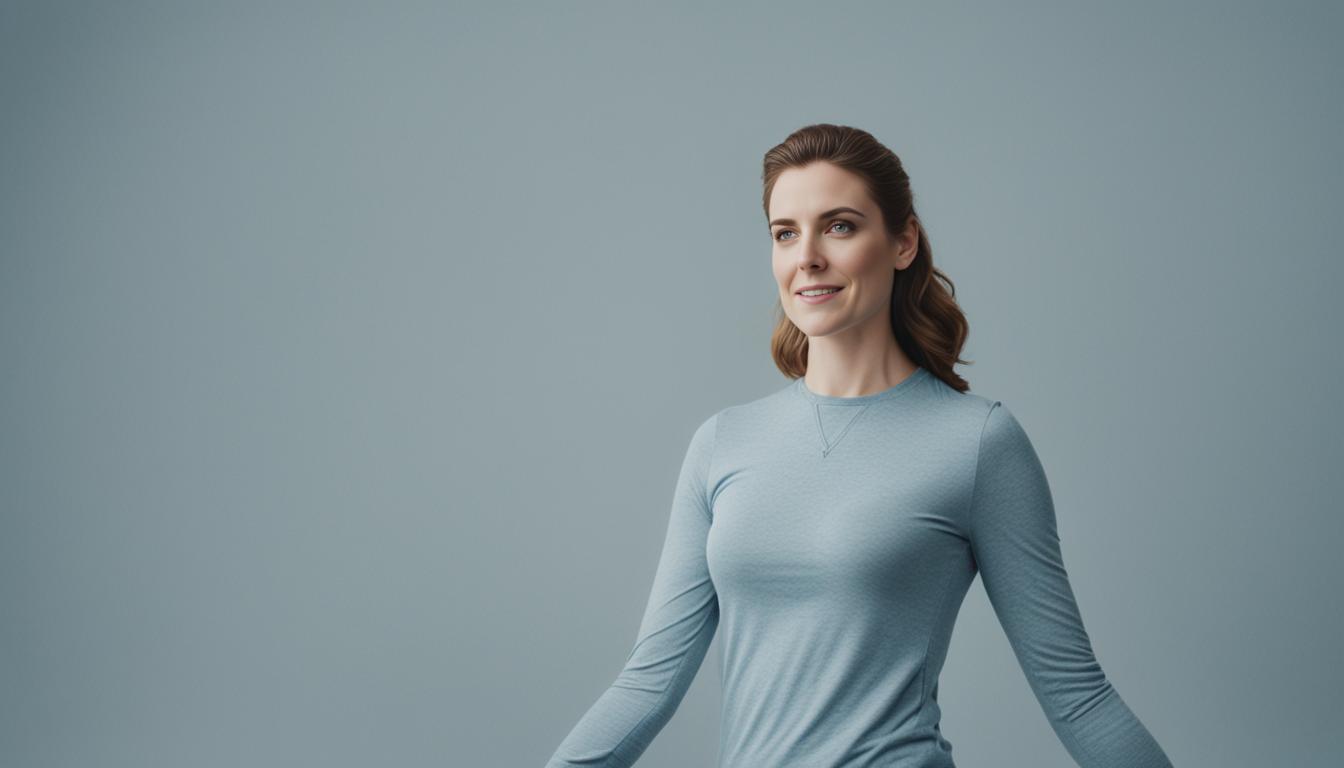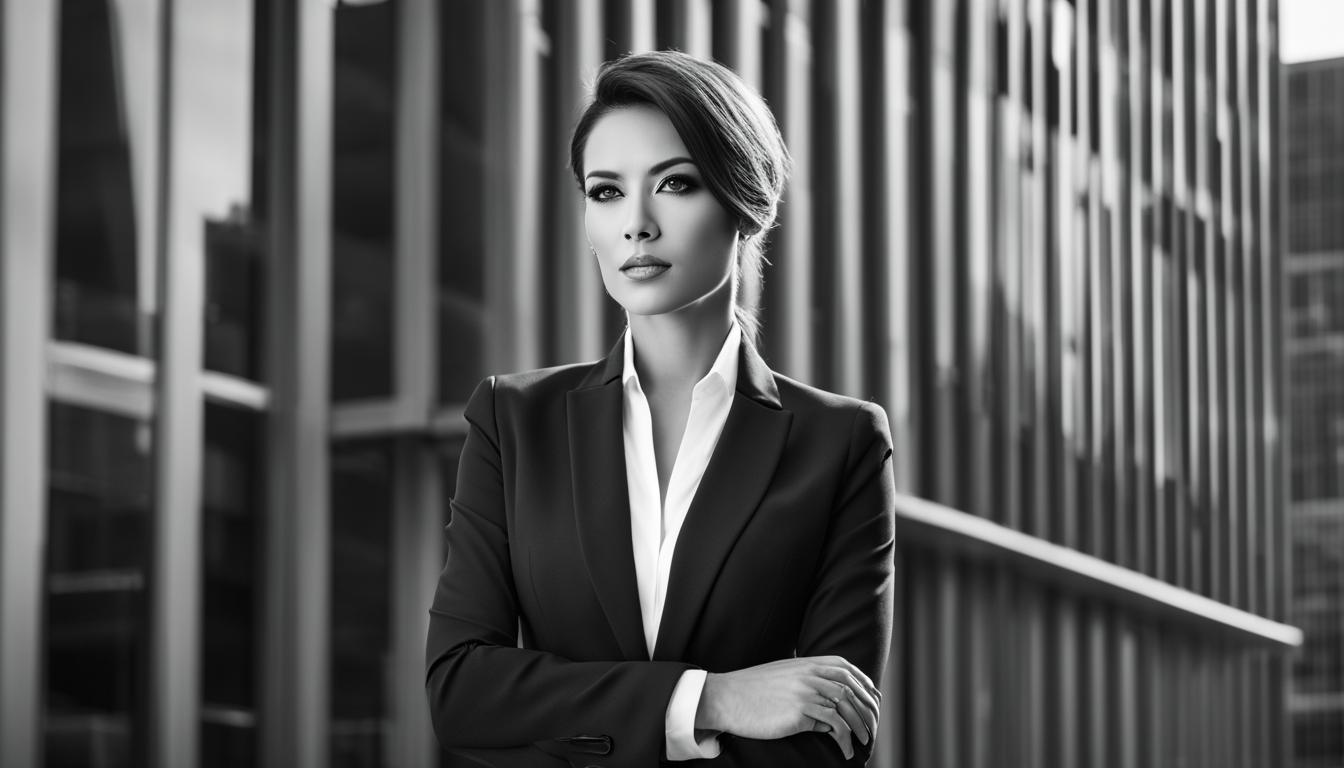Solo portrait photography is a wonderful way to express your creativity and capture stunning images. Whether you’re a beginner or looking to improve your skills, our posing techniques will help you create captivating solo portraits. From using mirrors to experimenting with different lighting techniques, there are many ways to pose for a solo portrait. In this article, we’ll explore various posing ideas and tips to elevate your solo portrait photography.
Key Takeaways:
- Explore different posing techniques to create captivating solo portraits
- Consider using mirrors for unique and creative self-portraits
- Embrace low-key lighting for dramatic and impactful solo portraits
- Add motion blur to capture dynamic and energetic self-portraits
- Think outside the box by experimenting with no-face self-portraits and recreating famous artwork
Using Mirrors for Creative Self-Portraits
Using mirrors in solo portraits can add a unique and creative touch to your photos. Instead of holding and controlling the camera while posing, using a mirror allows you to see the composition and focus on yourself as the subject. It can be challenging to find a creative approach and avoid cliches, but experimenting with different angles and poses can result in captivating self-portraits. Using mirrors is a popular technique that can enhance your solo portrait photography skills.
When using mirrors in self-portraits, consider the following tips:
- Position the mirror strategically to create interesting reflections and compositions.
- Experiment with different angles and perspectives to add depth and visual interest to your photos.
- Play with lighting to highlight specific features and create a dramatic effect.
- Use the mirror to frame your face or body in a creative way.
By incorporating mirrors into your self-portraits, you can create visually engaging and dynamic images that capture your unique personality.
Embracing Low-Key Lighting for Dramatic Solo Portraits
Low-key lighting is a technique that creates predominantly dark images with focused highlights. It adds a dramatic and eye-catching effect to solo portraits. By utilizing spot metering and adjusting exposure settings, we can capture captivating self-portraits with a dark and moody atmosphere.
This technique allows us to enhance the impact of our solo portraits by highlighting specific features or emotions through the interplay of light and shadow. The contrast between the dark background and the focused highlights draws attention to the subject, creating a sense of depth and intensity.
When working with low-key lighting, it is essential to carefully consider the placement and direction of light sources. By strategically positioning the light, we can create interesting shadows that enhance the overall mood and composition of the photograph.
Here are some key tips for embracing low-key lighting in your solo portraits:
- Use a single light source: To create a more dramatic effect, try using a single light source, such as a small speedlight or a studio strobe. This will help you control the direction and intensity of the light, resulting in more defined shadows and highlights.
- Experiment with backlighting: Placing the light source behind the subject can create striking silhouettes and add depth to your self-portraits. Play around with different angles and positions to achieve the desired effect.
- Consider using props and accessories: Incorporating props and accessories can further enhance the drama of your self-portraits. Experiment with unique elements like hats, scarves, or even a smoke machine to add visual interest and intrigue.
Take a look at this example of a stunning low-key lighting self-portrait:

Image: A captivating self-portrait using low-key lighting to create a moody and dramatic effect.
With low-key lighting, you have the power to create impactful self-portraits that grab attention and evoke emotions. Through careful manipulation of light and shadow, you can transform your photographs into captivating works of art.
Adding Motion Blur to Capture Dynamic Self-Portraits
Incorporating motion blur in self-portraits is a fantastic way to infuse your photos with a sense of movement and dynamism. By using a slow shutter speed and experimenting with different movements, you can create visually captivating and unique self-portraits that capture the essence of your energy and creativity.
When using motion blur in self-portraits, it’s important to consider the desired effect and the story you want to convey. Experiment with various shutter speeds to achieve the perfect level of blur that enhances the dynamic nature of your poses and adds an artistic touch to your photos. Remember, the amount of blur will depend on the speed and direction of the movement.
To capture motion blur in your self-portraits, follow these steps:
- Set your camera to manual mode: This allows you to have full control over your camera settings, including the shutter speed.
- Choose a slow shutter speed: Generally, a shutter speed of 1/30 or slower works best for capturing motion blur. However, you may need to adjust it based on the intensity of the movement and the lighting conditions.
- Use a tripod or stabilize your camera: To avoid camera shake, it’s crucial to keep your camera steady. Use a tripod or find a stable surface to place your camera on.
- Experiment with different poses and movements: Express your creativity by trying out different dynamic poses and movements. You can dance, jump, twirl, or engage in any activity that encapsulates your personality.
- Review and adjust: After capturing some shots, review them on your camera’s LCD screen and make any necessary adjustments to achieve the desired level of motion blur.
Remember, incorporating motion blur in self-portraits requires practice and experimentation. Don’t be afraid to try new ideas and push the boundaries of your creativity. With time, you’ll develop a unique style and capture stunning self-portraits that evoke a sense of movement and energy.
As Ansel Adams once said, “There are no rules for good photographs, only good photographs.” So go out there, have fun, and let your passion for self-expression shine through in your dynamic self-portraits.
| Benefits of motion blur in self-portraits: |
|---|
| 1. Adds a sense of movement and dynamism |
| 2. Infuses photos with an artistic touch |
| 3. Captures the energy and creativity of the subject |
| 4. Creates visually captivating and unique images |
Now that you have a solid understanding of how to add motion blur to capture dynamic self-portraits, it’s time to grab your camera and start experimenting. Embrace the freedom of creativity and create mesmerizing self-portraits that truly reflect your unique personality.
Exploring No-Face Self-Portraits for Artistic Expression
When it comes to self-portraits, we often think of capturing our face as the focal point. However, there is a whole world of artistic possibilities beyond traditional portraiture. Many artists believe that any part of your body can be used to create fascinating and abstract self-portraits. This unconventional approach challenges the norm and allows for unique and thought-provoking artistic expression.
By focusing on different body parts or using props to cover your face, you can create captivating self-portraits that leave room for interpretation. Absence of the face introduces an element of curiosity and invites viewers to engage with the image on a deeper level.
Embracing no-face self-portraits allows for endless creative opportunities. You can experiment with different angles, poses, and perspectives to showcase the beauty and intricacies of other body parts. Whether you choose to emphasize hands, feet, or other features, the abstract nature of these self-portraits lends itself to artistic exploration.
Inspired by minimalism and abstract art, no-face self-portraits challenge traditional ideas of self-portraiture and push the boundaries of what can be conveyed through photography. By removing the face from the frame, the focus shifts to the body’s form, movement, and aesthetics. This technique opens up a world of possibilities where you can explore your body as a canvas for artistic expression.
Abstract self-portrait ideas:
- Experiment with different body parts, such as hands, feet, or silhouettes, to create visually intriguing self-portraits.
- Use props, masks, or accessories to cover or hide your face, adding an element of mystery and intrigue.
- Play with lighting and shadows to create dramatic effects and enhance the abstract nature of your self-portraits.
- Explore unconventional perspectives and angles to capture unique compositions and add a sense of dynamism to your images.
- Consider incorporating nature or elements of the environment to create juxtaposition and add depth to your self-portraits.
Remember, no-face self-portraits offer a blank canvas for your creativity. By embracing this unconventional approach, you can challenge traditional notions of self-portraiture and create compelling, abstract images that evoke emotion and spark imagination.
Recreating Artwork for Unique Self-Portraits
Looking for a creative way to add depth and meaning to your self-portraits? Consider recreating famous paintings in your own unique style. This trend has gained popularity on platforms like Instagram, where individuals use self-portrait photography to pay homage to renowned artworks. By studying and analyzing famous paintings, you can incorporate their elements and style into your self-portraits, resulting in visually captivating images.
Recreating artwork in self-portraits allows you to merge the worlds of art history and self-expression. It provides an opportunity to showcase your creativity and reinterpret well-known pieces through your personal lens. By infusing your self-portraits with the essence of famous paintings, you can add a new layer of meaning to your photos and make a powerful artistic statement.

How to Recreate Artwork in Self-Portraits
- Select a Famous Painting: Choose a renowned artwork that inspires you. It could be a masterpiece from Van Gogh, Frida Kahlo, or Leonardo da Vinci. Consider the composition, colors, and overall style of the painting.
- Study the Painting: Analyze the details of the painting, such as the subject’s pose, facial expression, and the use of light and shadow. Try to understand the artist’s intention and the emotions portrayed in the artwork.
- Plan the Self-Portrait: Decide how you want to incorporate the painting’s elements into your self-portrait. Consider the props, background, lighting, and any additional accessories or clothing that may enhance the resemblance.
- Set up the Scene: Arrange the scene according to your planned self-portrait. Pay attention to the positioning of objects, lighting conditions, and any specific angles or perspectives that will help you achieve the desired effect.
- Strike a Pose: Pose yourself in a way that resembles the subject of the painting. Pay attention to your body language, facial expression, and overall mood. Experiment with different poses to find the one that best captures the essence of the artwork.
- Compose the Shot: Use your camera or smartphone to capture the self-portrait. Experiment with framing, angles, and focus to create a visually stunning image that closely resembles the original painting.
- Edit and Enhance: Use photo editing software to adjust the colors, contrast, and overall tone of the image. This step will help you further align your self-portrait with the original artwork and enhance its visual impact.
By following these steps, you can recreate famous artwork in your self-portraits and infuse them with your own creative touch. Remember, the goal is not to replicate the painting exactly but to use it as a source of inspiration and to add a unique perspective to your self-portrait photography.
Playing with Perspective and Objects in Self-Portraits
Incorporating objects and playing with perspective in self-portraits can add visual interest and creativity to your photos. By exploring different techniques and angles, you can create unique and compelling self-portraits that stand out.
One creative self-portrait idea is to use windows for reflections. By positioning yourself in front of a window, you can capture interesting reflections and create a captivating image. Experiment with different angles and compositions to achieve the desired effect. Here’s an example:
Another technique is to incorporate objects in your self-portraits. You can use props that represent your hobbies or interests to tell a story and add a personal touch to your photos. For instance, if you’re passionate about music, you can include musical instruments in your self-portraits. The key is to find objects that enhance the narrative and create visual intrigue.
Additionally, playing with perspective can produce striking self-portraits. Experiment with different placements and angles to create unique compositions. For example, you can hide parts of your face or body with objects to add an element of mystery or create a thought-provoking image. Don’t be afraid to think outside the box and push the boundaries of traditional self-portraiture.
Here’s a quote from renowned photographer Annie Leibovitz:
“You can’t use up creativity. The more you use, the more you have.” – Annie Leibovitz
So, when it comes to playing with perspective and incorporating objects in your self-portraits, remember to unleash your creativity and explore new possibilities. The beauty of self-portraiture lies in the ability to express yourself, tell a story, and capture unique moments through your lens.
Making Collages to Tell a Story in Self-Portraits
Capturing self-portraits is not limited to a single image. We can use collages to create a visual narrative that tells a story through self-portraits. By combining multiple photos, we can capture different aspects of our personality or experiences. Self-portrait collages allow us to expand our creativity and go beyond the confines of a single image.
There are various apps and software available that can assist in creating self-portrait collages. Alternatively, we can experiment with popular editing tools like Photoshop or Lightroom to bring our vision to life. These tools provide endless possibilities for arranging, overlapping, and blending photos to create a cohesive and visually appealing collage.
When creating a self-portrait collage, it’s important to consider the narrative or story you want to convey. Think about the emotions, themes, or concepts you wish to express, and select photos that align with your vision. Each photo within the collage should contribute to the overall narrative, creating a cohesive and engaging visual story.
Self-portrait collages give us the freedom to explore different perspectives, emotions, and moments in our lives. We can showcase our growth, challenges, or even portray a fictional character through carefully selected images. The collage becomes a medium to communicate our personal journey and connect with the audience on a deeper level.
Furthermore, self-portrait collages can encourage viewers to analyze and interpret the story behind the images. Each photo within the collage adds layers of meaning and invites viewers to delve into the narrative we have created. The juxtaposition of different images fosters curiosity and engagement, making self-portrait collages a powerful storytelling tool.
With self-portrait collages, we have the opportunity to push the boundaries of traditional self-portraiture and experiment with unique and creative compositions. By playing with the arrangement, size, and orientation of each image, we can create visually captivating and aesthetically pleasing collages that entice the viewer to explore further.
Creating a narrative through self-portrait collages allows us to tell our stories in a dynamic and engaging manner. It provides us with a platform to express ourselves, share our experiences, and connect with others on a deeper level. Self-portrait collages are not just a collection of photos; they are a window into our souls.
So let your creativity run wild and start making self-portrait collages that weave together the different chapters of your life. Embrace the power of storytelling through visuals and unlock a world of possibilities in self-expression.
Conclusion
Wrapping up our exploration of posing techniques for solo portraits, we hope you feel inspired to take your photography skills to the next level. By incorporating these techniques into your repertoire, you will be able to capture stunning images that truly reflect your creativity and personal style.
From using mirrors to experiment with different angles and perspectives, to playing with objects and incorporating them into your compositions, the possibilities for creating captivating self-portraits are endless. Remember to embrace the power of low-key lighting to add drama and impact to your images, and don’t shy away from incorporating motion blur for a dynamic and expressive effect.
As you continue on your solo portrait photography journey, we encourage you to explore different approaches and find your own unique voice. The key to mastery is practice, so keep experimenting, keep learning, and keep honing your skills. With each click of the shutter, you will refine your technique and create self-portraits that tell your story and captivate viewers.
Now, armed with these valuable posing techniques, it’s time to go out and capture the beauty of solo portraits. Unleash your creativity, embrace your unique perspective, and let your photographs speak volumes. Remember, the world is waiting for your artistry – go out there and create!
FAQ
What are some posing techniques for solo portraits?
Some posing techniques for solo portraits include using mirrors, embracing low-key lighting, adding motion blur, exploring no-face self-portraits, recreating artwork, playing with perspective and objects, and making collages.
How can I use mirrors for creative self-portraits?
Using mirrors in self-portraits allows you to see the composition and focus on yourself as the subject. It adds a unique and creative touch to your photos and allows for experimentation with different angles and poses.
What is low-key lighting, and how can I embrace it in my solo portraits?
Low-key lighting is a technique that creates predominantly dark images with focused highlights. By using spot metering and adjusting exposure settings, you can create dramatic and moody self-portraits with a dark atmosphere.
How can I add motion blur to capture dynamic self-portraits?
Adding motion blur to self-portraits involves using a slow shutter speed and experimenting with different movements. This technique adds a sense of movement and energy to your photos, allowing you to capture visually interesting and unique self-portraits.
Can I create self-portraits without showing my face?
Yes, you can create engaging and thought-provoking self-portraits without showing your face. Focusing on different body parts or using props to cover your face can result in fascinating and abstract self-portraits that challenge traditional ideas of self-portraiture.
How can I recreate famous artworks in my self-portraits?
To recreate famous artworks in your self-portraits, study the paintings and incorporate their elements and style into your photos. This creative approach adds depth and meaning to your self-portraits, merging the worlds of art history and self-portraiture.
How can I play with perspective and objects in self-portraits?
Incorporating objects and experimenting with perspective in self-portraits can add visual interest and creativity to your photos. You can use windows for reflections, hide parts of your face with objects, or try different placements and angles.
How can I make collages to tell a story in self-portraits?
Creating collages with multiple photos allows you to construct a visual narrative in your self-portraits. You can combine different images to capture various aspects of your personality or experiences, using apps, software, or editing tools like Photoshop or Lightroom.
What should I keep in mind when capturing solo portraits?
When capturing solo portraits, remember to experiment, practice, and find your unique style. Keep exploring different posing techniques, embrace your creativity, and strive to create compelling self-portraits that truly reflect your personality.




